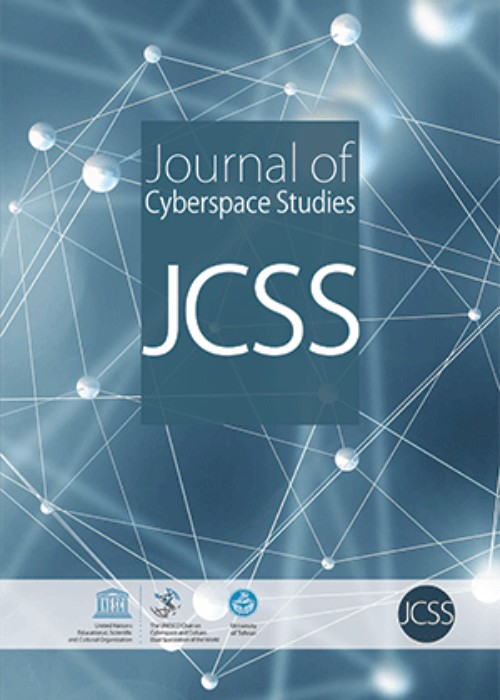فهرست مطالب
Journal of Cyberspace Studies
Volume:5 Issue: 2, Summer-Autumn 2021
- تاریخ انتشار: 1401/03/21
- تعداد عناوین: 5
-
Pages 85-114The learning approach to persuasion was considered obsolete following the emergence of new paradigms such as cognitive and constructive approaches. However, according to the evolutions of learning theories and especially the re-emergence of the connectivism paradigm, mainly due to what new technologies have provided, the learning approach to persuasion seems to have reappeared as a powerful approach that has a lot to offer yet. Based on research conducted on transformative learning patterns and algorithms, this paper investigates: i) the applicability of using the patterns and algorithms as well as techniques developed in the transformative learning approach for transformative persuasion, ii) how media can be used in the transformation process. The components of a persuasive transformation model, the factors involved, and major elements of each factor are extracted by constructivist grounded theory (CGT), which is used for theory building, accumulating knowledge and experiences of scholars, practitioners, and experts in adult learning. We show how media can use these factors and elements and notions and techniques developed in transformative learning for the persuasive transformation of their respective audience. Borrowing the concepts of transformative learning concerning the states of mind of the adult students in different stages of the transformation process, we suggest how media can appropriately act in each stage to facilitate a transformation through persuasion.Keywords: liminal space, media persuasion, PACT model of transformative persuasion, persuasive technologies, transformative learning, threshold concept
-
Pages 115-136With the popularity of online games, the overuse of these games has raised concerns. The literature has mainly conceptualized players’ psychosocial characteristics as risk factors for game addiction. However, many studies have confirmed that game structural characteristics play a more important role in players’ experience. Similarly, this research investigates how interactive affordances of World of Warcraft motivate players to play the game excessively. We have used two qualitative methods of Think-aloud protocol and in-depth interviews with World of Warcraft players. We recruited 35 World of Warcraft players from Singapore Nanyang Technological University in May 2021. Twenty of them participated in the in-depth interview and 15 of them participated in Think-aloud protocol sessions. We found that strong social ties in persistent groups encourage excessive gaming and causes sleep deficits, bad eating habit and ignoring real-life duties. Intra-group competition for outperformance encourages excessive gaming because players receive powerful items if they spend more time on gaming. Rewards and contingent tasks that are designed in games to encourage playing the game with time encourage players to play the game excessively. Finally, after explaining about gaps in knowledge, we discuss how our findings contribute to the literature. Implications for future research and insights to game addicts are provided.Keywords: game addiction, interactive affordances, massively multiplayer online games, online game players’ excessive gaming experience
-
Pages 137-162
Media is considered as one of the ideological apparatuses. This research is based on the question in parallel of enhancing technology and the formation of new media, as well as change passive audience into the active user, can these media still be called ideological? If so, the question is that how does the new media, despite the adaptation of interaction from the internet, find the ideological function? This paper discusses the role of the concept of the ideology for understanding social media critically. This study based on Althusser's definition of ideology and Habermas's theory about the public sphere creates consultative democracy led it to evaluate new media, their behavior and practices. The paper was developed based on a qualitative approach and descriptive-analytical method. As a result, new media owners are looking to create a two-tier Internet in which commercial content is more important than public content. Commercial content is managed by the ruling power and is governed by an ideology, which is the ideology of the ruling class. On the contrary, public content is controlled by media owners and contains a variety of ideologies that carry different ideas and meanings. The contemporary media system, through its ownership has divided media audiences into smaller groups (specific audiences), and has severely restricted fair access and participation in the public sphere, so that the ideological aspect of new media remains unchanged, but it emerges in the new shapes.
Keywords: Ideology, Internet, new media, Public Sphere, Social media -
Pages 163-176Anime is a popular media in Iran nowadays, and some anime Instagram fan pages have over 400 hundred followers. Iranian anime audiences use the Instagram platform to gain news about anime, access anime broadcast and download resources and share and audit unofficial fans' content creations. Due to the lack of news websites’ coverage about anime and lack of anime news websites in Persian, Iranian anime fan-pages admins volunteer to translate anime news, usually from English and share the contents on an Instagram platform for the rest of the audiences. Applying Henry Jenkins’ participatory culture and convergence culture concepts, we prepared a questionnaire. We asked 387 anime audiences who were Instagram users about how often they watch anime, how often they read and watch anime fan-pages content, how often they participate in fandom chats and discussions. We saw an evident association for watching anime and reading and watching anime fan-pages content, while we saw a moderate association for watching anime and participating in fandom chats and discussions.Keywords: Anime, fandom, participatory culture, Social media
-
Pages 177-180
Virtual Life in Iran: Emotions and Subcultures in Online Social Networks authored by Mohammad Saeed Zokaei & Simin Veisi. Tehran, Iran: Agah Publication, 2020. 528 pp., ISBN 978-964-416-442-2.
Keywords: affective turn, digital cultures, Emotions, Iran, online social networks, structure of feeling


